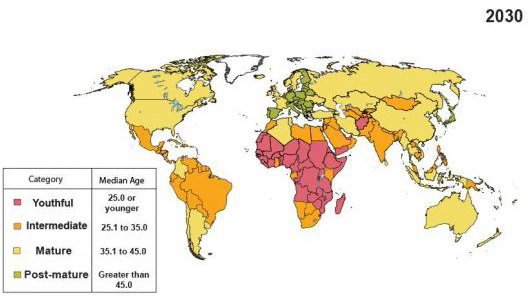-
Coming of Age: Reason for Optimism in Burma’s Turn Towards Democracy
›
Burma (also known as Myanmar), a country plagued by internal political turmoil and direct or tacit military rule since 1962, had its first general elections in 50 years in 2010 and long-time jailed opposition leader Aung San Suu Kyi won a seat in the National Assembly, but questions remain as to how much power the military is willing to cede. Demography provides reason for hope that this turn towards democracy is more than temporary.
-
A Roundup of the ‘Global Trends 2030’ Series on Population Aging
›
The National Intelligence Council is trying something new for this year’s Global Trends report: keeping a blog. So far, there have been postings from analysts and contributors on everything from migration and urbanization to international banking and precision strike capabilities, but over the past week, one of the most extensive series yet went up on demography. Though youth bulge theories have often dominated population-related security discussions, 11 posts highlight the newest and least understood of all demographic conditions: advanced population aging.
In parts of the world, mainly Europe and several countries in East Asia, populations are set to become “extremely mature” because of sustained declines in average fertility to very low levels and steady increases in lifespan. Demographers measure maturity by a population’s median age – the age of the person for whom precisely half of the population is younger and half older. Japan and Germany currently have the most mature populations; both are reported to have a median age slightly over 45 years. By 2030, UN Population Division and U.S. Census Bureau projections suggest that there may be between 19 and 29 countries that pass this benchmark. In Japan, the median age is projected to be 51.
If 5 out of 10 people in a country over 50 years old sounds unprecedented, that’s because it is. In this series, titled “Population Aging to 2030,” a group of political demographers, economic demographers, political scientists, and historians discuss the implications of this never-before-experienced set of age structures.
In his introductory essay, “Population Aging: A Demographic and Geographic Overview” (cross-posted here on New Security Beat), Richard Cincotta outlines the upcoming demographic trend, identifying the particulars of these novel age structures and indicating the regions that are expected to mature into economically and politically advantageous and disadvantageous demographic profiles.
In “Population Aging – More Security or Less?,” Jack Goldstone examines the effects on the U.S. military of a maturing developed world. With the United States and their traditional allies having proportionally fewer young people, will this impact limit their ability to put “boots on the ground?” Can new partnerships be developed in order to make up for this shortfall in man power?
In “China: the Problem of Premature Aging,” Richard Jackson focuses on China’s unique set of aging issues. Due to strict immigration laws and the one-child policy, China is experiencing the most rapid aging of the major powers. The favorable age structure which has enabled huge economic growth will soon shift to being a major burden on a relatively smaller working-age population, having potential political and societal consequences beyond that.
“The Sun Has Yet to Set on China” provides a different interpretation of the challenges China faces. Jennifer Dabbs Sciubba argues that although there will be changes in age structure, the problems may be overstated and the United States may still face a challenge to its status as sole global superpower.
In “Population Aging and the Welfare State in Europe,” Ronald Lee and Andrew Mason emphasize the stresses aging will exert on the extensive social welfare programs of many European states. The combination of longer life expectancy and declining fertility rates has led to a large and increasing funding gap in the welfare system, leaving questions as to the future viability of these programs.
In “Population Aging and the Future of NATO,” Mark Haas foresees that the welfare funding gap could have far-reaching international security consequences. With European governments diverting more and more resources away from military spending to fund welfare programs, the current U.S. irritation with NATO is likely to continue, as European allies “free ride” on the back of U.S. military supremacy in order to cut their defense budgets.
In “The Beginning of History: Advanced Aging and the Liberalness of Democracies,” Richard Cincotta examines the future of the liberal democratic political systems across aging countries. With increasing pressure on resources and a large disparity likely between the native born and migrant populations, it may become challenging for these states to remain liberal and democratic.
For Toshi Yoshihara, author of “The Strategic Implications of Japan’s Demographic Decline,” the aging process will pose a question of priorities for the leaders of Japan. The decreasing number of personnel available to the military, the effects of which were highlighted by the recent tsunami, will force a strategic decision between a defense force that is prepared primarily to address immediate and local security threats or one that is trained primarily for broader humanitarian interests.
“A Demographic Sketch of a Reunified Korea” provides interesting insights into the hypothetical demography of a single, unified Korea. Putting aside the two very distinct social paths that evolved during the past 60 year, Elizabeth Hervey Stephen uses demographic projections to envisage the challenges and opportunities that could arise from reunification.
David Coleman points to immigration as a possibly-mitigating force to aging in the developed world. In “The Impact of Immigration on the Populations of the Developed World and Their Ethnic Composition,” Coleman concludes that the developed world is likely to become “super diverse” by 2030. But this trend can be volatile. International migration is subject to many political and economic factors, bringing into question whether the developed world can rely on migration to supplement their native growth rates.
In “The Ethnic Future of Western Europe to 2030,” which wraps up the series, Eric Kaufmann examines the ethnic make-up of Western Europe in the coming decades. While the size of ethnic minority populations may be smaller than in the United States, the speed of growth in these minorities is likely to be much more rapid in Western Europe. This unprecedented increase in migrant populations could exacerbate ethnic social tensions, particularly in urban areas.
The broad nature of these essays suggests that advanced population aging will emerge within the context of many types of policy debates in the coming decades. While these 11 brief essays only scratch the surface of their respective areas of research, they provide a broad introduction to the politics of advanced population aging.
Jonathan Potton is a student at the University of Aberdeen and currently interning at the Stimson Center for demographer Richard Cincotta.
Sources: UN Population Division, U.S. Census Bureau.
Image Credit: Courtesy of Richard Cincotta. Data from U.S. Census Bureau’s international database. -
Population Aging: A Demographic and Geographic Overview
›The original version of this article, by Richard Cincotta, appeared on the National Intelligence Council’s Global Trends 2030 Blog. It is the first post in a series on population aging, featuring Jack Goldstone, Richard Jackson, Jennifer Dabbs Sciubba, Ronald Lee, Andrew Mason, Toshi Yoshihara, Elizabeth H Stephen, David Coleman, and Eric Kaufmann.
This series, Population Aging to 2030, begins with an introductory essay aimed at familiarizing readers with some of the demographic and geographic particulars of this phenomenon, and with several key demographic terms. The term most in need of definition is, of course, “population aging.” -
Urbanization and the Global Climate Dilemma
›
Urbanization and climate change may be the two most important trends to shape global development in the decades ahead. On the one hand, urban cities have the potential to serve as engines of change, driving economic growth in some of the world’s least developed countries and pulling more people out of poverty than at any other time in history. On the other hand, climate change could undercut all of this by exacerbating resource scarcity and putting vulnerable communities at risk from sea level rise and more frequent and intense storms.
-
Nine Strategies to Stop Short of Nine Billion
›Although most analysts assume that the world’s population will rise from today’s seven billion to nine billion by 2050, it is quite possible that humanity will never reach this population size.
My chapter in this year’s State of the World 2012: Moving Toward Sustainable Prosperity, “Nine Population Strategies to Stop Short of 9 Billion,” outlines a series of strategies that would prompt significant declines in birth rates. Based purely on the intention of women around the world to have small families or no children at all, these initiatives, policies, and changes in attitude could end population growth before mid-century at fewer than nine billion people.
Examples from around the world demonstrate effective policies that not only reduce birth rates, but also respect the reproductive aspirations of parents and support an educated and economically active society that promotes the health of women and girls. Most of these reproduction policies are relatively inexpensive to implement, yet in many places they are opposed on the basis of cultural resistance and political infeasibility.
In creating this list, I sought to eschew the language and approaches of “population control” or the idea that anyone should pressure women and their partner on reproduction. Instead, I hoped to highlight strategies that could put human population on an environmentally sustainable path:- Provide universal access to safe and effective contraceptive options for both sexes. With two in five pregnancies reported as mistimed or never wanted, lack of access to good family planning services is among the biggest gaps in assuring that each baby will be wanted and welcomed in advance by its parents.
- Guarantee education through secondary school for all, especially girls. In every culture surveyed to date, women who have completed at least some secondary school have fewer children on average, and have children later in life, than do women who have less education.
- Eradicate gender bias from law, economic opportunity, health, and culture. Women who can own, inherit, and manage property; divorce; obtain credit; and participate in civic and political affairs on equal terms with men are more likely to postpone childbearing and to have fewer children compared to women who are deprived of these rights.
- Offer age-appropriate sexuality education for all students. Data from the United States indicates that exposure to comprehensive programs that detail puberty, intercourse, options of abstinence and birth control, and respecting the sexual rights and decisions of individuals can help prevent unwanted pregnancies and hence reduce birth rates.
- End all policies that reward parents financially based on the number of children they have. Governments can preserve and even increase tax and other financial benefits aimed at helping parents by linking these not to the number of children they have, but to parenthood status itself.
- Integrate lessons on population, environment, and development into school curricula at multiple levels. Refraining from advocacy or propaganda, schools should educate students to make well-informed choices about the impacts of their behavior, including childbearing, on the environment.
- Put prices on environmental costs and impacts. In quantifying the cost of an additional family member by calculating taxes and increased food costs, couples may decide that the cost of having an additional child is too high. Such decisions, freely made by women and couples, can decrease birth rates without any involvement by non-parents in reproduction.
- Adjust to an aging population instead of boosting childbearing through government incentives and programs. Population aging must be met with the needed societal adjustments, such as increased labor participation, rather than by offering incentives to women to have more children.
- Convince leaders to commit to stabilizing population through the exercise of human rights and human development. By educating themselves on rights-based population policies, policymakers can ethically and effectively address population-related challenges by empowering women to make their own reproductive choices.
Kathleen Mogelgaard assisted with research for this piece.
Robert Engelman is the president of the Worldwatch Institute and contributing author to State of the World 2012: Moving Toward Sustainable Prosperity.
Sources: Bloom et al. (2011), Guttmacher Institute, Kohler et al. (2008), Population Reference Bureau, UN, UNFPA, The Wall Street Journal, Yadava and Yadava (1999).
Image Credit: Worldwatch Institute, State of the World 2012: Moving Toward Sustainable Prosperity. -
Poor Land Tenure: A Key Component to Why Nations Fail
›The murder of five land rights campaigners during the last two months – one in Colombia, three in Brazil, and one in Cambodia – have not captured many headlines, but they are a reminder of the central role land tenure plays not just in rural economic development but also in sparking broadly distributed economic gains throughout a society.
-
Philippines’ Bohol Island Demonstrates Benefits of Integrated Conservation and Health Development
›
In March 2012, I participated in a study tour to the island of Bohol, near the unique Danajon double barrier reef ecosystem – the only one of its kind in the Philippines and one of only three in the Indian and Pacific Oceans. Nowhere is the connection between population dynamics and biodiversity more evident than in the Philippines, one of the most densely-populated countries on the planet, with more than 300 people per square kilometer. Nearly every major species of fish in the region shows signs of overfishing, according to the World Bank.
-
A Northern View: Canada’s Climate Claims and Obligations
›Reneging on Kyoto, Keystone pipeline drama, pain at the pump, re-aligned Arctic sovereignty, melting outdoor hockey rinks – all these aspects of climate change are being discussed in Canada.
However, Canadians, as potential citizens of the next energy superpower, need a more comprehensive and enriching debate. Climate change adaptation measures, at home and abroad, are inevitable, but the issue has largely been ignored by the federal government thus far.
To many Americans, it may seem that Canada has equated energy production with national prosperity, but Canadians are increasingly concerned about the human security and eco-justice implications of ongoing climate change as well. Lack of leadership at the federal level on Kyoto-related energy efficiency and emissions mitigation has been partially offset by actions at the provincial and municipal levels, but climate change is occurring now and it demands a coordinated response from the federal government, the only political apparatus capable of channeling the resources necessary for making a solid contribution to global climate change adaptation.
A moderate predictive scenario suggests that the regional impacts of climate change will be very expensive: the UN projects the global Green Climate Fund will require up to $100 billion a year by 2020. Water stress – too little, too much, or the perception of either – may be the most common theme. Coastal flooding, shoreline erosion, glacier retreat, chronic water shortages, loss of biodiversity and habitat, increased spread of invasive species, extreme weather events; taking preventive action against these (beyond the obvious call for reduced emissions) will be prohibitively expensive for most communities around the globe, including the coastal and northern regions of Canada.
The UN Convention to Combat Desertification has become a conduit for the argument that drought and land degradation related to climate change justifies southern demands for northern investment in initiatives in Africa and elsewhere. As a high emissions per capita nation, Canada has an obligation to contribute to such international efforts.
But I also don’t see why the indigenous peoples of the circumpolar north should be denied claims as permafrost thaws and ice-cover vital for subsistence hunting disappears. Citizens of small island states, to whom adaptation may well mean the abandonment of their homeland, have charged willful ignorance or purposeful negligence of their plight; so too might riparian communities along Canada’s many ocean shorelines, lakes, and rivers. Farmers, fishers, First Nations communities: all will need to adapt. We need to start seriously planning ahead to meet climate change scenarios, instead of burying the issue under the tar sands.
Of course, people will adapt to shifting conditions; such is the imperative of survival. And there are many ingenious ways this will materialize. Indeed many mitigation and adaptation strategies blend together as hybrids today. Building more effective alternative energy systems can be seen as much as responses to climate change as preventive measures and involve both public and private sector funding, for example.
However, paying for adaptation is another matter, and here it is vital in my view to stress the potential role of infrastructure spending by the federal government. Much of Canada’s current fiscal restraint is indeed a welcome development if the government cuts back on waste and redundancy, but not if it serves as a veil for sacrificing principles of eco-justice – the idea that those who made the least contributions to and benefit the least from environmental problems should not bear disproportionately higher risks.
Of course there will be nasty disputes ahead about the accounting, accountability, legitimacy, and purpose of climate change adaptation funding for Canada, in or out of the UNFCCC process, but let me draw just a few general conclusions at this stage:- There is an ethical imperative to contribute to international adaptation funding, perhaps just as great an imperative as traditional efforts to help former colonized countries. It’s not just about money, at least not directly: Canadian technical, policy, and financial expertise should be harnessed for this purpose as well.
- Unlike in other policy areas, there is no way to unload or pass the buck on climate change adaptation efforts: they demand the utilization of centralized resources redistributed throughout the country and through multilateral funding mechanisms.
- Adaptation funding should not, however, supplant more traditional emergency, humanitarian, or environmental funding. It should be seen as a supplement, albeit one with increasing importance, but not as a new form of dependency or gold-rush of aid-with-obligations opportunities. The current government is right to worry about accountability issues.
- But accountability goes both ways: we need at least to get the accounting and communications right on this, thus the need for open dialogue and ongoing consultation. Killing the well-respected National Roundtable on the Environment and the Economy, which consulted various Canadian stakeholders on key environmental questions, was not a good start.
Peter Stoett is the Fulbright Research Chair in Canada-U.S. Relations at the Wilson Center’s Canada Institute and professor in the Department of Political Science at Concordia University, Montreal.
Sources: CBC, The Catholic Register, The Huffington Post, International Institute for Sustainable Development, UNFCCC.
Photo Credit: “City, Suburb, Ocean, Mountain,” courtesy of flickr user ecstaticist (Evan Leeson).
Showing posts from category Guest Contributor.










